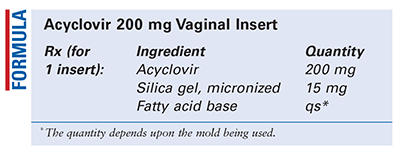US Pharm. 2019;44(9):48-CV3.

Method of Preparation: Calibrate the specific mold(s) to be used for preparing these inserts. Calculate the required quantity of each ingredient for the total amount to be prepared. Accurately weigh and/or measure each ingredient. Mix the acyclovir with the silica gel. Warm the fatty acid base until melted; do not overheat. Slowly and with stirring, incorporate the acyclovir and silica gel powders and mix well. Remove from heat and, with continued stirring, pour the mixture into the mold(s). Allow the mixture to cool to room temperature and solidify. Package and label.
Use: Acyclovir vaginal inserts have been used in the treatment of herpes.1,2
Packaging: Package in tight, light-resistant containers.
Labeling: Keep out of reach of children. Refrigerate. Use only as directed. For vaginal use. Discard after ____ [time period].
Stability: A beyond-use date of up to 6 months may be used for this preparation.3
Quality Control: Quality-control assessment can include weight, specific gravity, active drug assay, color, texture–surface, appearance, feel, melting test, physical observation, and physical stability.4
Discussion: Acyclovir is commonly used as a topical, injectable, or oral treatment for genital herpes and cold sores. Herpes refers to a group of viruses that cause a variety of herpes infections, including genital herpes, shingles, chickenpox, cold sores, and encephalitis. Genital herpes refers to a sexually transmitted disease that any sexually active person can contract and transmit. Available dosage forms for acyclovir include an injectable solution (50 mg/mL), oral suspension (200 mg/5 mL), powder for injection (500 mg/vial, 1 g/vial), 400-mg and 800-mg tablets, and a 200-mg capsule.1,2 The drug is not commercially available as a vaginal insert.1,2
Acyclovir (C8H11N5O3, MW 225.20) is a synthetic purine nucleoside analogue that occurs as a white to off-white, crystalline powder that is slightly soluble in water and insoluble in alcohol. It melts at temperatures above 250°C with decomposition. Acyclovir should be preserved in tight containers. The injection has a pH of 11.0 to 12.5.1-3
Silica gel, a form of silicon dioxide, is obtained by insolubilizing the dissolved silica in sodium silicate solution. If it is obtained by adding sodium silicate to a mineral acid, it is called silica gel, but if obtained by the destabilization of a solution of sodium silicate to yield very fine particles, it is called precipitated silica. Silica gel occurs as a fine, white, hygroscopic, odorless, amorphous powder with a usual particle size ranging from 2 µm to 10 µm. It is insoluble in water and alcohol and in other organic solvents, but it is soluble in hot solutions of alkali hydroxides. Silica gel is used as a desiccant, suspending agent, and viscosity-increasing agent.3,5
Fatty acid base, also called Hard Fat USP, is a mixture of glycerides of saturated fatty acids. These suppository bases consist mainly of mixtures of the triglyceride esters of the higher saturated fatty acids (C8-C18), with varying proportions of monoglycerides and diglycerides. Of the numerous products available, selection may be made based on their physical properties, including acid value, hydroxyl value, iodine value, melting point, saponification value, solidification point, and unsaponifiable matter. Their labeling is to include the nominal melting temperature (27°C-44°C). These products should be preserved in tight containers at a temperature that is at least 5°C below the melting range stated in the labeling. Hard Fat occurs as a white mass that is almost odorless and free from rancid odor, and it is greasy to the touch. On warming, it melts to a colorless or slightly yellowish liquid. When the melted material is shaken with an equal quantity of hot water, a white emulsion is formed. Fatty acid base is practically insoluble in water and slightly soluble in alcohol, and it is freely soluble in ether.3,6
REFERENCES
1. RxList. Acyclovir. www.rxlist.com/consumer_acyclovir_zovirax/drugs-condition.htm. Accessed August 7, 2019.
2. Drugs.com. Acyclovir. www.drugs.com/acyclovir.html. Accessed August 7, 2019.
3. U.S. Pharmacopeia/National Formulary [current revision]. Rockville, MD: U.S. Pharmacopeial Convention, Inc; August 2019.
4. Allen LV Jr. Summary of quality-control testing for sterile and nonsterile compounded preparations, part 1: physical and chemical testing. IJPC. 2019;23(3):211-216.
5. Hapgood KP. Colloidal silicon dioxide. In: Sheskey PJ, Cook WG, Cable CG, eds. Handbook of Pharmaceutical Excipients. 8th ed. London, England: Pharmaceutical Press; 2017:255-259.
6. Moreton RC. Suppository bases, Hard Fat. In: Sheskey PJ, Cook WG, Cable CG, eds. Handbook of Pharmaceutical Excipients. 8th ed. London, England: Pharmaceutical Press; 2017:959-963.
To comment on this article, contact rdavidson@uspharmacist.com.





